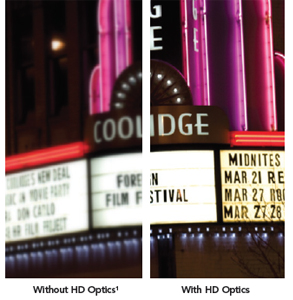If 3D movies cause eye strain or discomfort, you may have a vision problem.
3D movies are becoming all the rage lately. Hollywood puts out more and more new 3D offerings in theaters every year, and an increasing number of television shows allow for 3D viewing as well.
But if the 3D experience makes you feel sick or causes headaches, or if you simply can’t see the 3D effect, this could be a sign of undiagnosed vision problems.
Fortunately your local eye doctor can help.
Binocular vision is vital to see 3D
The reason that 3D television and movie experiences work – or don’t – is because of a process known as binocular vision.
In a healthy visual system, both your eyes are properly in sync, moving in unison to look at a certain object or point in space. Each eye sends visual information back to the brain, where it is interpreted.
The two eyes working together and being in slightly different positions is vital for the brain to create 3D images.
Binocular vision simply means the brain is using both eyes at the same time – which is essential for us to see clear and single 3D images of the world around us.
3D shows and movies use two cameras, just like our two eyes, to create a double image on the screen, which allows your brain to perceive the movie in three dimensions.
Back when 3D was first introduced, this was done by separating images into green and red wavelengths and having audiences wear red/green glasses.
These days the 3D is more realistic as the camera techniques use polarized light to separate two sets of images. Movie viewers use polarized glasses, which look like regular sunglasses, to see the 3D effect.
Why can 3D movies cause problems?
If you experience eye strain or headaches from 3D viewings, or simply cannot see the 3D images, you may have a binocular vision problem.
The most common symptoms of discomfort that people report during or after watching a 3D movie or TV show are headaches, blurry vision, fatigue and nausea. In some instances, the show or movie doesn’t appear in 3D to them at all.
When the brain cannot combine the images from the two eyes, it works harder to try to create a single, clear and comfortable image – causing eye strain and other symptoms.
SEE RELATED: The 5 Most Frequent Binocular Vision Problems
If you or a child don’t enjoy 3D movies, contact your local eye doctor for an eye exam.
Examples of binocular vision issues that can cause problems when watching 3D entertainment are:
1. Convergence or divergence problems
Problems with the efficient and accurate use of these vision skills can be a significant source of eye strain, headaches and fatigue when trying to watch 3D presentations.
Convergence is the eyes’ ability to turn inward to focus in unison on a single close-up object or point in space.
Divergence is the eyes’ ability to turn outward together to focus on a single object or point in space at a distance.
3D entertainment requires the viewer to constantly switch focus from the foreground (converging) to the background (diverging), and back again.
2. Lazy eye (amblyopia)
Lazy eye is a binocular vision disorder that occurs when one eye is ‘weaker’ than the other. This causes a significant difference in the visual information sent by the two eyes to the brain.
Examples of conditions that can cause amblyopia would be a pronounced eye turn (strabismus) or significantly greater near or far-sightedness in one eye compared to the other.
This results in the brain being unable to properly combine images from each eye into a coherent picture. The brain’s way of coping with this issue is to begin ignoring visual information sent from the weaker eye, essentially reducing your visual system to input from only the stronger eye. This causes a loss of binocular vision and depth perception.
Since watching 3D entertainment requires depth perception and the use of both eyes to differentiate between the two images on the screen, conditions such as amblyopia can cause a person to be unable to view the entertainment in anything more than two dimensions.
3. Focusing (accommodation) issues
Accommodation refers to the eyes’ ability to maintain clear focus while switching between near and distance vision.
3D entertainment requires a constant switching between objects that seem to be closer and farther away. A person whose eyes don’t accommodate properly will experience blurry vision.
The repeated need to refocus vision each time there is a change from distance to near vision, and back again, can cause headaches and eyestrain when attempting to watch 3D movies and shows.
How can my eye doctor help?
Don’t ignore these signs, as binocular vision problems could negatively impact a child’s learning or an adult’s work performance.
As part of a functional eye exam, your eye doctor can detect if you have any form of binocular vision dysfunction and how best to treat it.
Successful treatment of binocular vision issues usually requires optical corrections and/or vision therapy.
Vision therapy is a treatment program customized to your specific visual needs that uses a customized regime of exercises to help strengthen coordination between the brain and the visual system.
In most cases, a personalized vision therapy program will involve both in-office therapy sessions and at-home exercises. Patients who commit to both, achieve the best results.
LEARN MORE: Guide to Vision Therapy
If you think you may have a binocular vision problem, schedule an appointment with an eye doctor near you.
If 3D experience makes you or your child feel sick or causes headaches, or you simply can’t see the 3D effect, you may have undiagnosed vision problems.
Don’t ignore these signs, as binocular vision problems could negatively impact a child’s learning or an adult’s work performance.










